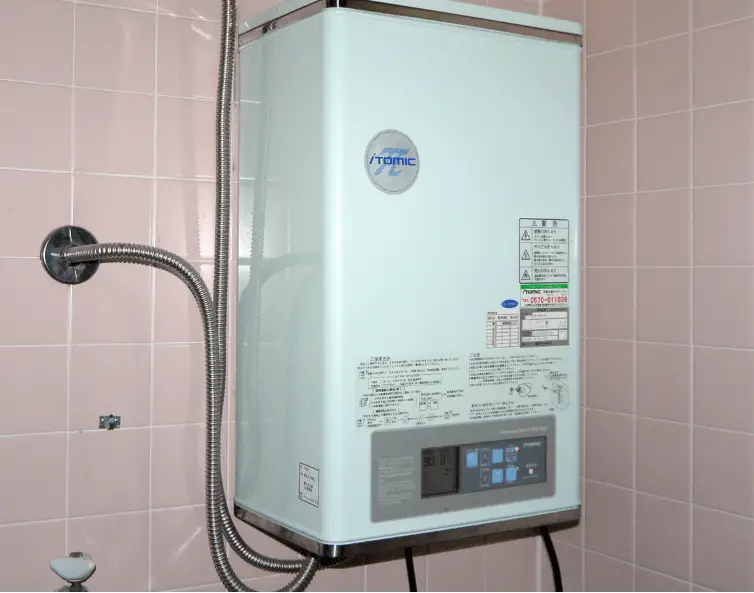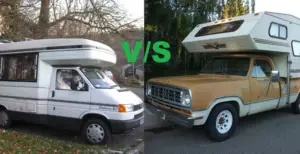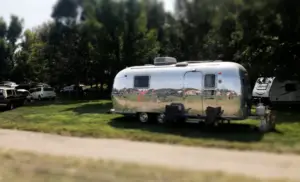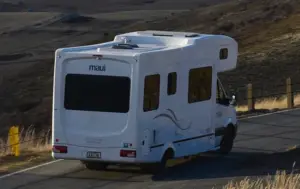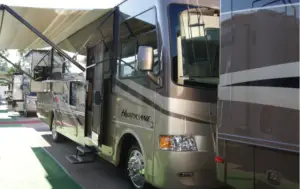When travelling in your RV, problems are bound to arise in one form or another. Among some of the common problems is RV water heaters. This article will present some common issues with RV water heaters and some troubleshooting tips.
Below you will see a few RV water heater problems most commonly reported for the various types of travel trailers and RVs.
Common Problem 1: Water Will Not Heat Up
There could be various reasons that the water will not heat up in the RV. Sometimes it is just the simple turn of a valve at the water heater itself.
This valve is called a bypass valve.
This valve regulates whether or not the flow of water will go into the water heater itself and begin heating.
Its setup this way for a process called weatherization.
A bypass valve will prevent other liquids such as antifreeze from flowing into the water heater during warmer months and causing unnecessary damage to the system.
The valve should be in an open position for winter time or for heating needs, and closed when not in use (i.e. when the RV is in storage, or it is determined that hot water wont be necessary for a particular trip.)
If not then now you know to turn the valve and to be mindful of this next time.
Another thing to pay attention to is whether or not you have a tankless RV water heater or one with a tank. If it is electric or if it is gas powered.
Should you have one with a tank and is gas powered, then take care to look at the pilot area, where you can see the flame that is ignited and heating the water heater.
It should be blue in color with yellowish tips in the flame. If it is a yellow flame then the problem could be debris inside the tubing which you would then need to clear out.
If you are utilizing a tankless water heater and its gas powered, then you should check to see if there are any damaged parts inside the casing of the water heater.
Check your manual to see how to flush the gas and water tubing to possibly clear any debris. Check for any corroded or damaged working parts.
Checking the Thermostat
Thermostats are used to regulate a certain temperature to be set for simultaneous heating and cooling of the water that passes through the RVs’ water heater.
This is a recommended first check as thermostats are among one of the most common problems for insufficient water heating or no hot water at all. If the thermostat is faulty then the control circuit board wont go through its process of turning on the heat for the heater.
Check the thermostat by wiggling the wires between the thermostat sensors and the control circuit board, and if the light on the circuit board blinks on and off then you have a faulty thermostat.
When checking the wires, also known as Emergency Cut Off or E.C.O connectors. Inspect the connectors for loose terminals or dirty terminals and that they are not faulty.
If the terminals that connect to the sensors are loose, then squeeze them with a tool if necessary to make sure there is a snug fit. If the E.C.O terminals at the ends of the wires seem to worn or unmanageable then consider replacing those as well.
If the terminals happen to be dirty then they can be cleaned with an electrical cleaner.After checking the Emergency Cut Off connectors, check the Thermal Cut Off fuse. Use a tool for checking connectivity of the fuse.
If the fuse registers on a meter then no replacement is necessary. Turn your attention towards the thermostat sensors. Pick up some sensors from either the dealer you got the RV from or a second hand repair shop. Make sure you know the make and model of your RV and the make and model of your water heater so you can be sure to have the right parts. Since you are already in the process of troubleshooting your thermostat, changing the sensors isn’t a bad idea.
That way you will know if another problem arises, its definitely not the thermostat or any sensors involved with it. Once you have the right parts then proceed to replace the old sensors with the new ones. Refer to your owners manual or research on the internet to see exactly how this can be done.
After checking everything, turn on the hot water inside the RV and check that the thermostat is working properly. Also, consider that there are different models and variations of RV water heaters. So the specific checks, troubleshooting and replacements will differ with each one. Be sure to specify the necessary method for a solution so that you can smoothly carry out your plan of action
(Note: adjust maintenance checks for electric powered and gas powered water heaters)
Common Problem 2: Water Has A Pungent Odor
The reason for having a foul smelling odor in your running water in an RV could be because of an anode that sits inside the heater is corroded and needs to be changed.
The anode collects bacteria that gets inside the water heating system and over time can build up. All of the bacteria that is collected is a type of sulfide and is what causes the foul smell. So to combat that,
remove the anode and check to see if it can be cleaned or if it needs to be replaced completely. after checking anode, proceed to flush out the water heater and the tubing of the water already in it, and to rid it of calcium and other build up that is loose that may have occurred.
There are a number of solutions that work in clearing out the build up inside of the water heater system.
One is hydrogen peroxide another is vinegar.
Pour these liquids of your choosing, or if you find another liquid solution to use, pour those into your water heater system and let set for a while so that the liquids will begin to eat away and loosen up the calcified areas in the system.
Afterwards, purge the water heater system of the liquids and loose debris and flush with clean distilled water or water that is readily available. Do this until you are confident that there is no more loose debris or build up inside the system. Replace any parts that have been removed and you are clean and good to go!
Common Problem 3: Soot Build Up
While soot build up is not a common problem, it is a problem regardless. You may say its not a major problem and that it should be normal for soot to build up when a gas powered heater is in operation. Not entirely true though.
If you have soot build up, this could mean that there are loose parts or misaligned parts in your RVs water heater. Things like loose wiring or damaged insulation of those wires.
Not paying attention to these particular instances could cause an unwanted fire. If working parts are misaligned in the water heater and left unattended to then further breakdown of the water heater system bound to be imminent.
Blockages on the main burner can cause soot build up. The main burner itself could be misaligned and if that is the case, then soot build up could be least of your problems later on down the road.
If the main burner is misaligned and not burning what its supposed to, then what is it burning? So think of soot build up as a type of warning or check light, informing you to perform some routine maintenance on your water heater.
As often as a blocked U tube or also known as the burner tube shows up in most solutions for problems with a water heater. It too could be the cause of soot build up in the area of the water heater.
The air shutter for the main burner may have soot build up on it, and if so this could mean that shutter itself is not adjusted properly.
A damaged air shutter may seem like a small thing but keep in mind that every part in that RVs’ water heater system is working in unison to complete the task it was designed for. So if one piece is out of sync then it will cause a ripple effect throughout the whole system.
Common Problem 4: Pilot Not Lighting
Referring back to problem one, this could be an obvious reason for your water not heating up. To further investigate this problem, here are a few conditions to look out for.
Obstructed U tube (burner tube)- there is an opening in this tube which will allow you to put a small wire brush in and clean out any obstruction that maybe in the way. Or if you have some compressed air with a nozzle, you can spray inside the tube and clear it out that way.The thermocouple is weak- could be corroded or just replace it altogetherIrregular air adjustment
These are a few things that could be prohibiting the lighting of your pilot.
Common Problem 5: Erratic Main Burner Flame
This problem is described as an intermittent flame, or simply the flame goes in and out. While there could be multiple reasons that this happens, commonly there could be a blockage of some sort. Whether it is in the burner tube, or the main burner itself.
Also, you should be aware of the gas supply line. This could be bent and should be replaced immediately before further use. As with previous solutions of any blockages, clear them out. Use the tools necessary to do so, and remember if you aren’t sure what to do, turn off the system and proceed to a mechanic who can help.
Regularly scheduled maintenance programs will surely prevent most if not all of these problems.
The maintenance cant happen if you the owner does not implement a course of action. It is solely up to you to make sure that you maintain the upkeep of your lovely RV or Travel Trailer.
Doing the maintenance
Keep in mind that these are brief explanations of problems and solutions to common problems.
Proper and thorough maintenance checks should be done two weeks, one week and a day before departure and the day of departure before leaving for your trip.
This allows time to gather parts and fix any problems that may have occurred without you being aware. The excitement can cause you to forget to do so, but by doing a RV water heater maintenance check beforehand can save a lot of trouble later and even more so, money! Always carry the manual for your RV and any mechanical working parts on your trip.
If you are not comfortable with doing these checks yourself, take the time before leaving for your trip to bring your RV to a certified mechanic in the trade.
They will go over the system checks for you and ensure the vehicle or trailer is ready for the adventure. Also, ask the mechanic to show you some common problems that may occur while operating the RV or trailer and ask him or her to show you how to counter these problems with solutions.
A mechanic would most certainly be happy to provide you with the information and visuals. You will be much more at ease knowing that you can keep you, your family and friends comfortable while out on your trip.
One more piece of advice.
When you or a mechanic does a maintenance check ahead of time, you could actually buy parts to keep with you in a storage should it be necessary to change out some parts during the journey.
Again it will save time and money, possibly avoiding tow fees and fees for the RV being held on a yard somewhere. Following this advice will definitely assure a smooth transition from home to trip destination and back home again, safe, relaxed and sound.

